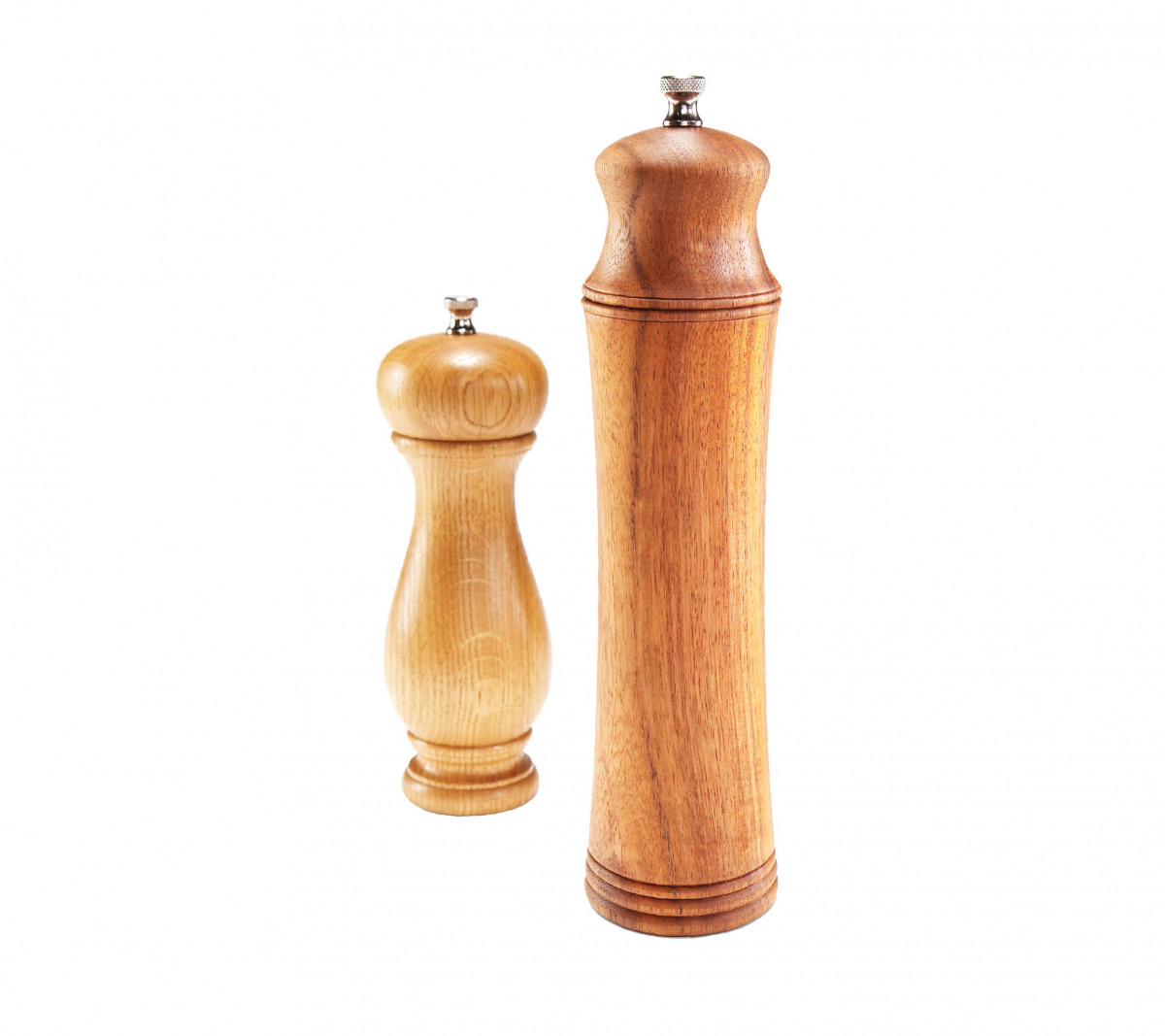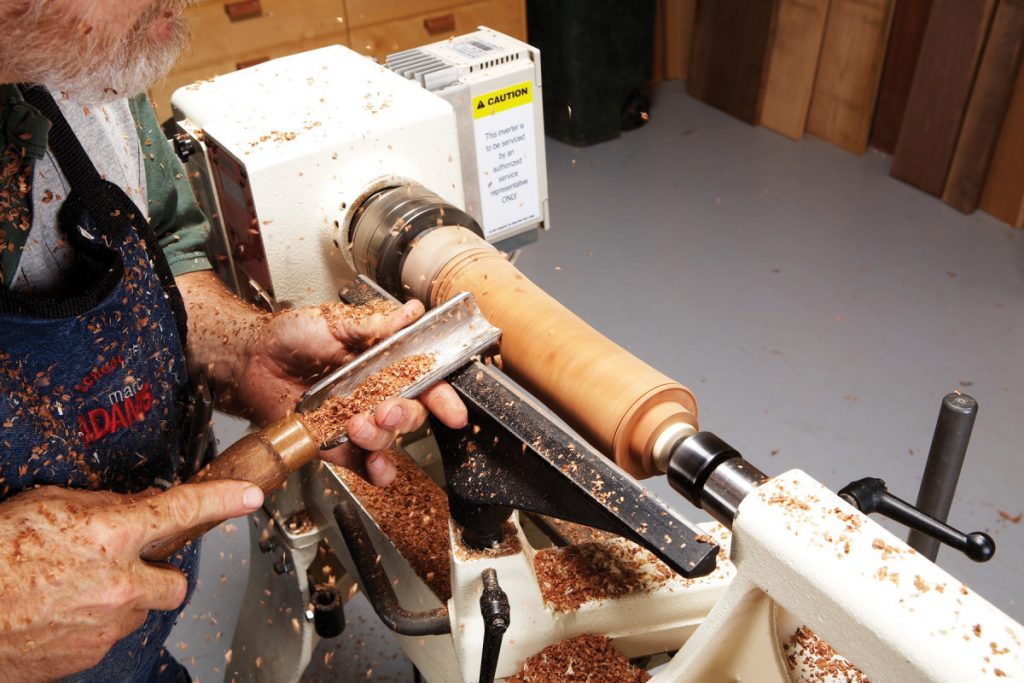
We may receive a commission when you use our affiliate links. However, this does not impact our recommendations.
 Turn a useful and beautiful object.
Turn a useful and beautiful object.
When it comes to pleasing the senses, a well-turned pepper mill has a lot going for it. It pleases the eye, is comfortable to hold and feels smooth to the touch. Of course, there’s always that wonderful taste and smell that only fresh ground pepper can deliver. Keep these things in mind as you follow me in creating your own pepper mill.
Your first consideration is the mill mechanism. Mills come in lengths from 3 inches to 24 inches with 8″ and 10″ being the most popular. For this story I used a 10″ mechanism with a nut on top.
You can also get mechanisms with crank handles, mechanisms that adjust from the bottom (no nut on top), or mechanisms that crush rather than grind. My rule of thumb; buy the best quality mill mechanism available. In other words, don’t try and save money here. The time and effort you invest are the major costs involved and a poor quality mill will only make your creation frustrating to use.
Your next step is to select the wood. Domestic woods such as walnut, cherry, and maple are a good choice for pepper mills. Tropical woods are another choice. I used Hawaiian Koa for the mill in this story. The wood blank should be 2 1/2″ to 3″ diameter and 1 1/2″ to 2″ longer than the mill hardware to allow for waste.
The way I turn pepper mills often varies from the instructions that come with the mill hardware. The instructions are useful for some critical dimension and assembly guidelines. Don’t get frustrated if the first couple of mills you turn aren’t perfect. I think you have to turn five to ten mills before you can develop your own system and refine your shapes.
Prep the Blank
1 Cut the wood blank 1 1/2″ to 2″ longer than the hardware, to allow for waste and a tenon between the cap and the body.
2 Cut the block of wood to separate the cap piece and the mill body (Image 1). I like to place the tenon on the mill body, because it makes the cap a little lighter. I usually cut about 13/4″ off the blank for the cap and allow for a 3/8″ to 1/2″ long tenon on the body.

1. Cut the pepper mill blank to separate the cap from the body. Place a large “V” over the cut area to help keep the parts correctly oriented. Cut a 11/2″ long waste block for chucking and drilling.
3 Turn all three pieces to cylinders. Then cut tenons on the top of each one to fit your scroll chuck.

2. Cut tenons on the tops of all three pieces. Make anoth-er orientation mark after the cylinder is formed.
4 Mount the base tenon into the scroll chuck. Face off the end of the body with a parting tool, to make it square to the sides and flat.
Drill the Body
5 Place a Jacobs-style chuck in the tailstock. Remove the tool rest and slide the base toward the headstock. Wear a full faceshield for all drilling operations.
6 Drill a 1 5/8″ diameter hole to a depth of 1/2″. You can also cut this hole with a parting tool or a skew chisel held flat on the rest in a scraping mode.

3. Mount the mill body in the scroll chuck by its tenon. Drill the 1/2″ deep hole at the bottom of the mill body with a 1 5/8″ bit in Jacobs-style chuck.
7 Place a 11/16″ bit in the Jacobs-style chuck and drill about three-quarters of the way through the body (Image 4). Work slowly and back the bit out frequently to remove chips or the bit may overheat. Excessive heat can ruin your bit and possibly crack the wood.
Alternate Method: The 11/16″ hole is required only for the first 1″ above the 15/8″ hole. You can drill the body using a more common 1″ bit and then widen the hole for that lower 1″ section with a round nose scraper.

4. Drill the smaller 11/16″ hole approximately three-quarters of the way through the body. Tall pepper mills like this one, may require a bit extension. A piece of tape indicates the stop point.
8 Clean up the bottom of the mill body using a skew chisel held flat on the rest to lightly scrape the end grain (Image 5). The base should be flat.

5. Scrape the end grain on the bottom of the mill body. Use a light touch and keep the skew chisel flat and horizontal on the rest.
9 Mount the waste block into the scroll chuck. Create a tenon for a jam fit with the large hole on the mill body (Image 6). The length of the tenon is slightly less than the hole’s depth. The fit is critical. It must be tight enough to hold the mill secure for turning, but loose enough to remove the body without undo force. Approach the diameter sizing carefully—as every cut is double. In other words, if you push in 1/32″ you remove 1/16″ of diameter. The shoulder of the waste block tenon should be flat or slightly concave.

6. Mount the waste block in the scroll chuck and cut a tenon to fit the hole in the mill body. The fit must be tight enough to hold the mill body for drilling and turning.
10 Mount the mill body on the waste block and finish drilling the 11/16″ hole from the top (Image 7).

7. Mount the mill body on the waste block tenon—a technique known as “jam chucking.” Complete the drilling from the top of the mill body.
Shape the Body
11 With the interior work complete, it is time to turn the outside of the body. First, turn a small cork-shaped block of wood to fit the hole in the mill body (Image 8). This will allow you to use the tailstock to support the body. On some lathes, there may be a tapered cone area on the tailstock’s center that will fit the 11/16″ hole. There are also large aftermarket cones available that function much like my wooden cork.

8 Plug the hole with a turned wood-en “cork.” With the hole plugged, the tailstock can be used to support the mill body while turning the exterior.
12 With the plug in place, bring the tailstock up and turn the body to the desired shape. I like to make the diameter of the body larger at the base than at the top, with a nice inward curve in the middle for the hand. This general shaping is done with a spindle-roughing gouge (Image 9).

9. Use the spindle-roughing gouge to shape the mill body. Switch to a detail spindle-gouge or a skew for detail work like beads.
13 Use a detail-spindle gouge or a skew chisel to do the detail work. I often turn one to three beads at the base of the body, and something a bead at the top, where the cap and body will meet—but these are design questions for you, the maker.
14 With the detailing complete, remove the tool rest, put on a dust mask and sand until there are no visible scratches (Image 10).

10. Sand the completed mill. If the turning went well, you should be able to start with 120 or 150-grit. Continue sanding with finer paper up to 220 or 320-grit or until all scratches are removed.
15 Before you remove the body from the lathe, finish the tenon area (Image 11). The length is 3/8″ to 1/2″. The shoulder should be flat or slightly concave.

11. Turn the mill body tenon approximately 1/2″ larger than the hole in the body. Cut the top and shoulder of the tenon clean and square by scraping with a skew.
16 Remove the mill body and the waste block from the lathe.
Shape the Cap
17 Place the cap tenon into the scroll chuck. Use the Forstner bit to drill the cap about 1/4″ deeper than the length of the tenon on the body (Image 12).

12 Mount the mill cap in the scroll chuck. Drill a flat-bottomed hole approximately 1/4″ deeper than the length of the tenon on the mill body.
18 Install the 1/4″ bit in the Jacobs-style chuck and drill through the cap (Image 13).

13. Drill a 1/4″ hole through the cap and into, but not through, the tenon. Work slowly, removing the bit and chips frequently to avoid binding and overheating.
19 Now it’s time to compare the hardware dimensions with the mill you have created thus far. Place the mechanism into the body. Screw the cap nut all the way down then, back it off one full turn.
20 Measure to determine the cap’s length (Image 14).
 21 Widen the hole in the cap to fit the tenon on the body. This fit should be a little loose for easy pepper grinding. I widen the hole for either a parting tool or a skew held flat and horizontal on the rest.
21 Widen the hole in the cap to fit the tenon on the body. This fit should be a little loose for easy pepper grinding. I widen the hole for either a parting tool or a skew held flat and horizontal on the rest.
22 Establish the length of the cap by cutting in with the parting tool, about one-fourth of the way down.
23 Use the detail/spindle gouge to shape the outside of the cap (Image 15). To check the overall look of the mill I often turn the lathe off and put the body on the cap.

15. Shape the outside of the cap with the detail/spindle gouge. The goal is to have something that feels wonderful in the hand and looks pleasant to the eye.
24 Remove the cap from the scroll chuck. Mount the waste block back in the scroll chuck and create a new tenon or jam chuck for the cap.
25 Turn away the remaining waste material on the cap to achieve the final length (Image 16). When you’re satisfied with the shape and quality of your turning, go ahead and sand the cap.

16. Jam-chuck the cap onto a new, larger tenon cut on the waste block. Turn the cap it its final shape and length.
26 The mechanism I’ve chosen uses four small screws to secure the mill in the base. Pre-drill each of the holes with the 1/16″ bit. Screw the mill hardware in place. Add the cap and nut and see how it performs.

17. Assemble the parts with the supplied screws. These screws are small and break easily so be sure to pre-drill.
The Finish
There are several considerations when choosing a pepper mill finish. A pepper mill is a hand-operated tool that holds a food items and is frequently exposed to moisture from boiling pots of gourmet goo. Hands are abrasive and acidic—even when they’re clean. Most film-type finishes, including wax, lacquer, shellac and varnish don’t wear well on a pepper mill. I lean towards oil or an oil/varnish blend, such as pure tung oil, walnut oil and Danish-oil finishes.
Materials List
Wood
• A wood block 2 1/2″ to 3″ diameter and 1 1/2″ to 2” longer than the mechanism
• 3″ diameter waste block (grain length wise as the mill) that’s 2″ to 3″ in length
Mill Mechanism
• Suggested size: 10″ mill mechanism
Hardware
• Scroll chuck
• Jacobs-style chuck
• 11/16″ Forstner style drill bit(a 1″ bit can be used and the hole slightly enlarged by turning)
• 15/8″ drill bit (this too can be turned)
• 1/4″ drill bit extension
• 1/16″ bit for drilling pilot holes for mill mechanism screws (Bit sizes may vary depending on the mechanism used)
• Spindle roughing gouge – any size
• Detail/spindle gouge –3/8″ suggested
• Skew chisel –1/2″ or larger
• Parting tool –3/16″ or 1/4″
Product Recomendations
Here are some supplies and tools we find essential in our everyday work around the shop. We may receive a commission from sales referred by our links; however, we have carefully selected these products for their usefulness and quality.
read more at https://www.popularwoodworking.com by Alan Lacer
Woodworking








